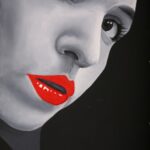
Ališauskaitė Kristina
Kristina Ališauskaitė (b. 1984) – a young artist who just this year completed her master’s studies at the Vilnius Academy of Arts. However, her consistently developed painterly style distinguishes her work within the context of Lithuanian painting and allows viewers to immediately recognize her unique artistic signature.
In terms of artistic expression, K. Ališauskaitė’s paintings are minimalistic: monochromatic compositions with lone figures wandering through vast spaces. Yet this minimalist and restrained visual language is enough to generate the artwork’s powerful emotional impact. The emptiness—so prominent in Kristina’s canvases (a large part of the surface remains unfilled by objects)—creates a strong sense of tension, which becomes the dominant emotional atmosphere of the paintings.
This tension is also present on a thematic level. The titles of her works alone suggest emotional states and feelings such as coldness, alienation, loneliness, and jealousy. The ethereal space of her paintings evokes dreamlike scenes, images emerging from the subconscious. The recurring motifs and themes from one composition to the next hint at the traumatic nature of the depicted situations. However, their repetition also provides a form of therapy—a kind of confession that brings relief. The artist subtly employs psychoanalytic insights, as if posing a riddle about how much of her personal experience is embedded in her work. There is a degree of autobiography in Kristina’s art. She appears to expose herself, yet doesn’t fully let the viewer in—offering her experiences as universal. The fragmented compositions suggest a fleeting, incidental glance, turning the viewer into a secret observer and provoking them not only to descend into the artist’s subconscious but also to explore their own hidden corners.
The sense of universality in the depicted scenes is reinforced by the figures acting within them. That they are recognizable from the imagery circulating in mass culture reveals the artist’s intention to critique materialism and consumerism. She exploits the imagery of pop culture and advertising, but reinterprets it—stripping away the obligatory eroticism and glossy appeal, and instead making them strange, even uncomfortable for easy consumption. The women painted in cold greyish and bluish tones are objectified, resembling plastic dolls or mannequins. This strategy proves effective: the imagery grabs attention, but its artificial coldness and removal from a familiar entertainment context compel the viewer to reconsider and re-evaluate the visuals and meanings broadcast by culture.
Thus, K. Ališauskaitė’s painting—marked by refined form, visual allure, emotional and conceptual depth—stands out as one of the more compelling discoveries in contemporary Lithuanian painting.




